Novel Electromagnetic Characterization Methods for New Materials and Structures in Aerospace Platforms
Abstract
:1. Introduction
2. Materials and Methods
2.1. Materials
- Methacrylate: Most commonly used plastic with good radome performance in the microwave and millimeter wave ranges. It is moderately priced, easily molded and machinable [23].
- FDM process can be used to fabricate complex geometries or internal structures and has been widely applied in many industries, such as the aerospace industry [26].
- Quartz and Polyethylene fibers: These types of fibers are used as reinforcement in prepreg materials. They have excellent electrical properties for a low-loss radome.
- Quartz has a high silica content, resulting in a low dielectric constant and a small loss tangent. It is higher in cost but offers potential lower losses than a polyethylene radome [23].
- Regarding the samples of quartz and polyethylene that will be studied in this article, one sample has been fabricated with Epolam 2025 resin with quartz fibers and another sample has been fabricated with Epolam 2025 resin and polyethylene fiber. For both cases, both samples have dimensions of 30 cm × 30 cm and are 4.4 mm thick. Moreover, Epolam 2025 is a blue-colored epoxy-type resin. This color can be seen in both samples (see Figure 5).
2.2. Methods
2.2.1. Microstrip Transmission Line Measurement Method
2.2.2. Free Space Measurement Method
- It will be necessary to make a total of three measurements for each material to be tested and for each of the parameters S: first the measurement of the material itself arranged as it appears in Figure 8, a second measurement where the free space (air) is measured, and the third measurement that corresponds to a metal plate (both used as reference).
- Once these three measurements have been made, using the S-parameters ( and ) for each of them, it is possible to obtain the transmission and reflection coefficients sought.
- However, the measured S-parameters are influenced by multipath propagation, unwanted reflections and other interference, especially in a non-anechoic environment. As a consequence, a gating of the signal in the time domain is performed. In this way, we will have the parameter just after the material and the parameter before the material. This process can be carried out using the VNA, but it is of vital importance to determine the test window correctly to avoid disturbances in the values obtained for reflection and transmission.
- Once the gating has been applied, obtaining the reflection and transmission from the S-parameters, respectively, is as follows:
2.2.3. Shielding Effectiveness Measurement Method
3. Results and Discussion
3.1. Microstrip Transmission Line Measurement Method
3.2. Free Space Measurement Method
3.2.1. Validation with Teflon and Eccostock Hick
3.2.2. Quartz and Polyethylene Fibers
3.2.3. Methacrylate, HIPS, PETG, PLA
3.3. Shielding Effectiveness Measurement Method
4. Conclusions
Author Contributions
Funding
Institutional Review Board Statement
Informed Consent Statement
Data Availability Statement
Acknowledgments
Conflicts of Interest
Abbreviations
| EM | Electromagnetic |
| CFC | Carbon Fiber Composites |
| HIRF | High Intensity Radiated Fields |
| UAV | Unmanned Aerial Vehicle |
| MALE | Medium Altitude Long Endurance |
| RPAS | Remotely Piloted Aircraft System |
| INTA | National Institute of Aerospace Technology |
| RF | Radiofrequency |
| HIPS | High Impact Polystyrene |
| PETG | Polyethylene Terephthalate Glycol |
| PLA | Polylactic Acid |
| FDM | Fused Deposition Modeling |
| SE | Shielding Effectiveness |
| CAEM-Lab | Laboratory of Computational and Applied Electromagnetism |
| DAK | Dielectric Assessment Kit |
| OECP | Open Ended Coaxial Probe |
| VNA | Vector Network Analyzer |
| BIANCHA | Bistatic Anechoic Chamber |
| RC | Reverberant Chamber |
| LUF | Lowest Usable Frequency |
| PSO | Particle Swarm Optimization |
| FSS | Frequency Selective Surface |
References
- Tameh, T.A.; Sawan, M.; Kashyap, R. Fly-by-wire flight control smart optical rotary sensor for aircraft. Photonics North 2016, 1. [Google Scholar] [CrossRef]
- Lee, J.; Song, Y. Study of electromagnetic environmental effects on the airworthiness certification for performance improvement aircraft. In Proceedings of the 2017 International Symposium on Electromagnetic Compatibility—EMC EUROPE, Angers, France, 4–7 September 2017. [Google Scholar] [CrossRef]
- Baker, A.A.; Scott, M.L. Composite Materials for Aircraft Structures, 3rd ed.; American Institute of Aeronautics and Astronautics, Inc.: Reston, VA, USA, 2016; ISBN 978-1-62410-629-3. [Google Scholar]
- Wang, E.; Zhang, S.; Zhang, Z. Research on composite material uav low-cost avionics system prototype. In Proceedings of the 8th International Conference on Wireless Communications, Networking and Mobile Computing, Shanghai, China, 21–23 September 2012. [Google Scholar] [CrossRef]
- Zhu, L.; Li, N.; Childs, P.R.N. Light-weighting in aerospace component and system design. Propuls. Power Res. 2018, 7, 103–119. [Google Scholar] [CrossRef]
- Zhu, L.; Li, N.; Childs, P.R.N. Additive manufacturing (3D printing): A review of materials, methods, applications and challenges. Compos. Part B Eng. 2018, 143, 172–196. [Google Scholar]
- Cabello, M.R.; Fernández, S.; Pous, M.; Pascual-Gil, E.; Angulo, L.D.; López, P.; Riu, P.J.; Gutierrez, G.G.; Mateos, D.; Poyatos, D.; et al. SIVA UAV: A Case Study for the EMC Analysis of Composite Air Vehicles. IEEE Trans. Electromagn. Compat. 2017, 59, 1103–1113. [Google Scholar] [CrossRef] [Green Version]
- Martínez, D.P.; Somolinos, D.R.; Poyatos, D. Electromagnetic Characterization of Materials Through High Accuracy Free Space Measurements. In Proceedings of the 15th European Conference on Antennas and Propagation (EuCAP), Dusseldorf, Germany, 22–26 March 2021. [Google Scholar]
- Davenport, C.; Rigelsford, J. Novel indoor bistatic measurement facility for full-scattering characterisation of surfaces at oblique incidence. J. Electromagn. Waves Appl. 2014, 28, 1798–1806. [Google Scholar] [CrossRef]
- Tamburrano, A.; Desideri, D.; Maschio, A.; Sarto, M.S. Coaxial waveguide methods for shielding effectiveness measurement of planar materials up to 18 ghz. IEEE Trans. Electromagn. Compat. 2014, 56, 1386–1395. [Google Scholar] [CrossRef]
- UAVE3—Presentation. Numerical and Experimental Assessment of Electromagnetic Environmental Effects in Unmanned Aerial Vehicles. Available online: https://www.inta.es/uave3/en/presentation/ (accessed on 1 April 2022).
- Romero, S.F.; Rodríguez, P.L.; Bocanegra, D.E.; Martínez, D.P.; Cancela, M.A. Comparing Open Area Test Site and Resonant Chamber for Unmanned Aerial Vehicle’s High-Intensity Radiated Field Testing. IEEE Trans. Electromagn. Compat. 2018, 60, 1704–1711. [Google Scholar] [CrossRef]
- Cytec MTM45-1. Available online: https://www.solvay.com/en/product/mtm45-1 (accessed on 11 May 2022).
- HexTow IM7. Available online: https://www.hexcel.com/user_area/content_media/raw/IM7_HexTow_DataSheet.pdf (accessed on 11 May 2022).
- MTA 240. Available online: https://www.solvay.com/en/product/mta-240 (accessed on 19 May 2022).
- Futatsumori, S.; Kohmura, A.; Yonemoto, N. Evaluation of microwave shielding characteristics of quasi-isotropic carbon fiber reinforced plastic laminates based on unidirectional materials. In Proceedings of the Asia Pacific Microwave Conference Proceedings, Kaohsiung, Taiwan, 4–7 December 2012; pp. 289–291. [Google Scholar] [CrossRef]
- Galehdar, A.; Nicholson, K.J.; Rowe, W.S.T.; Ghorbani, K. The conductivity of unidirectional and quasi isotropic carbon fiber composites. In Proceedings of the 40th European Microwave Conference, Paris, France, 28–30 September 2010; pp. 882–885. [Google Scholar] [CrossRef]
- Munalli, D.; Qaseer, M.T.A.; Zoughi, R. Modified Waveguide-Based Method for Microwave Characterization of High-Loss Materials. IEEE Trans. Instrum. Meas. 2022, 71, 6002310. [Google Scholar] [CrossRef]
- Gupta, H.; Agnihotri, P.K.; Basu, S.; Gupta, N. Electrical Characterization of Carbon Fiber Reinforced Polymer Composites. In Proceedings of the IEEE Electrical Insulation Conference (EIC), Denver, CO, USA, 7–28 June 2021; pp. 535–538. [Google Scholar] [CrossRef]
- Yin, W.; Withers, P.J.; Sharma, U.; Peyton, A.J. Noncontact Characterization of Carbon-Fiber-Reinforced Plastics Using Multifrequency Eddy Current Sensors. IEEE Trans. Instrum. Meas. 2009, 58, 738–743. [Google Scholar] [CrossRef]
- Cherry Titanium Maxibolt. Available online: https://www.cherryaerospace.com/docs/catalogs/CA-1010.pdf (accessed on 11 May 2022).
- Hysol EA9394. Available online: https://www.henkel-adhesives.com/us/en/product/industrial-adhesives/loctite_ea_9394.html (accessed on 11 May 2022).
- Kozakoff, D.J. Analysis of Radome-Enclosed Antennas, 2nd ed.; Artech House Inc.: Boston, London, 2016; ISBN 978-1-59693-441-2. [Google Scholar]
- Chandrashekarappa, M.P.G.; Chate, G.R.; Parashivamurthy, V.; Kumar, B.S.; Bandukwala, M.A.N.; Kaisar, A.; Giasin, K.; Pimenov, D.Y.; Wojciechowski, S. Analysis and Optimization of Dimensional Accuracy and Porosity of High Impact Polystyrene Material Printed by FDM Process: PSO, JAYA, Rao, and Bald Eagle Search Algorithms. Materials 2021, 14, 7479. [Google Scholar] [CrossRef] [PubMed]
- Arrigo, R.; Frache, A. FDM Printability of PLA Based-Materials: The Key Role of the Rheological Behavior. Polymers 2022, 14, 1754. [Google Scholar] [CrossRef] [PubMed]
- Hashmi, S.; Masood, S.H. Comprehensive Materials Processing, Volume 10: Advances in Additive Manufacturing and Tooling, 1st ed.; Elsevier: Amsterdam, The Netherlands, 2014; pp. 69–91. [Google Scholar]
- Baker-Jarvis, J.; Janezic, M.D.; DeGroot, D.C. High-Frequency Dielectric Measurements. IEEE Instrum. Meas. Mag. 2010, 13, 24–31. [Google Scholar] [CrossRef]
- ASTM International Standard D4935-18; Standard Test Method for Measuring the Electromagnetic Shielding Effectiveness of Planar Materials. ASTM International: West Conshohocken, PA, USA, 2018.
- International Electrotechnical Commission Standard IEC61 000-4-21; Electromagnetic compatibility—Part 4–21: Testing and measurement techniques—Reverberation chamber test methods. International Electrotechnical Commission: Geneva, Switzerland, 2011.
- Plaza, B.; de Francisco, P.; Romero, S.; Rebate, I.; Ramos, D.; Poyatos, D. Limitations in the Shielding Effectiveness Measurement Methods for Carbon Fiber Composites. IEEE Electromagn. Compat. Mag. 2021, 10, 52–61. [Google Scholar] [CrossRef]
- Plaza, B.; López, D.; Poyatos, D. Characterization of Joints between Carbon Fiber Composite Parts Using a Microstrip Transmission Line Method. Sensors 2021, 21, 1142. [Google Scholar] [CrossRef]
- DAK, Professional Handbook V2.0, Schmid & Partner Engineering AG. Available online: https://speag.swiss/products/dak/overview/ (accessed on 13 May 2022).
- Shull, P.J. Nondestructive Evaluation: Theory, Techniques, and Applications; CRC Press: Boca Raton, FL, USA, 2002; ISBN 9780824788728. [Google Scholar]
- Saboroux, P.; Boschi, P. EpsiMu: A New Microwave Materials Measurements Kit. In Proceedings of the European Test & Telemetry Conference (ETTC), Toulouse, France, 1 January 2005. [Google Scholar]
- Basics of Measuring the Dielectric Properties of Materials; Application Note 5989-2589; Keysight Technologies: Santa Rosa, CA, USA, 2014.
- Borgstrom, E.J. An overview of the EMC requirements in RTCA/DO-160D. In Proceedings of the 1998 IEEE EMC Symposium. International Symposium on Electromagnetic Compatibility. Symposium Record (Cat. No.98CH36253), Denver, CO, USA, 24–28 August 1998; Volume 2, pp. 702–707. [Google Scholar]
- BASF Products—Styrodur. Available online: www.styrodur.com (accessed on 4 May 2022).
- Musil, J.; Zacek, F. Microwave Measurements of Complex Permittivity by Free-Space Methods and Their Applications. In Studies in Electrical and Electronic Engineering; Elsevier: Amsterdam, The Netherlands, 1986; Volume 22, pp. 44–60, 92–166. [Google Scholar]
- Hollinger, R.D.; Jose, K.A.; Tellakula, A.; Varadan, V.V.; Varadan, V.K. Microwave characterization of dielectric materials from 8 to 110 GHz using a free-space setup. Microw. Opt. Technol. Lett. 2000, 26, 100–105. [Google Scholar] [CrossRef]
- Schultz, J.W. Focused Beam Methods, Measuring Microwave Meterials in Free Space; CreateSpace Independent Publishing Platform: Scotts Valley, CA, USA, 2012. [Google Scholar]
- Escot, D.; Poyatos, D.; Aguilar, J.A.; Montiel, I.; González, I.; Saez de Adana, F. Indoor 3d full polarimetric bistatic spherical facility for electromagnetic tests. IEEE Antennas Propag. Mag. 2010, 52, 112–118. [Google Scholar] [CrossRef]
- Gonçalves, F.J.F.; Pinto, A.G.; Mesquita, R.C.; Silva, E.J.; Brancaccio, A. Free-Space Materials Characterization by Reflection and Transmission Measurements using Frequency-by-Frequency and Multi-Frequency Algorithms. Electronics 2018, 7, 260. [Google Scholar] [CrossRef] [Green Version]
- Spinner. “3 1/8” EIA to N Female Adapter. Available online: https://products.spinner-group.com/3-1-8-eia-to-n-female-adapter-bn945700 (accessed on 4 May 2022).
- Angulo, L.M.D.; de Francisco, P.G.; Gallardo, B.P.; Martinez, D.P.; Cabello, M.R.; Bocanegra, D.E.; Garcia, S.G. Modeling and Measuring the Shielding Effectiveness of Carbon Fiber Composites. IEEE J. Multiscale Multiphys. Comput. Tech. 2019, 4, 207–213. [Google Scholar] [CrossRef]
- MEGA PRC-20. Available online: https://www.mega.es/?sIdioma=en (accessed on 5 May 2022).
- Micro-Ohmmeter Model 580 from Keithley. Available online: http://www.testequipmenthq.com/datasheets/KEITHLEY-580-Datasheet.pdf (accessed on 5 May 2022).
- Kennedy, J.; Eberhart, R.C. Particle swarm optimization. In Proceedings of the ICNN’95-International Conference on Neural Networks, Perth, WA, Australia, 27 November–1 December 1975; Volume 4, pp. 1942–1948. [Google Scholar]
- Balanis, C.A. Advanced Engineering Electromagnetics, 1st ed.; Jhon Wiley & Sons: Toronto, ON, Canada, 1989; ISBN 0-471-62194-3. [Google Scholar]
- Eccostock HIK 500, High Temperature Tuned Low Loss Dielectric Stock, Laird Technologies, a DuPont Business. Available online: https://www.laird.com/products/microwave-absorbers/low-loss-dielectrics/eccostock-hik-500 (accessed on 5 May 2022).
- Fernandez, S.; Gutierrez, G.; Diego, I. A shielding effectiveness prediction method for coupled reverberant cavities validated on a real object. J. Electromagn. Waves Appl. 2015, 29, 1829–1840. [Google Scholar]
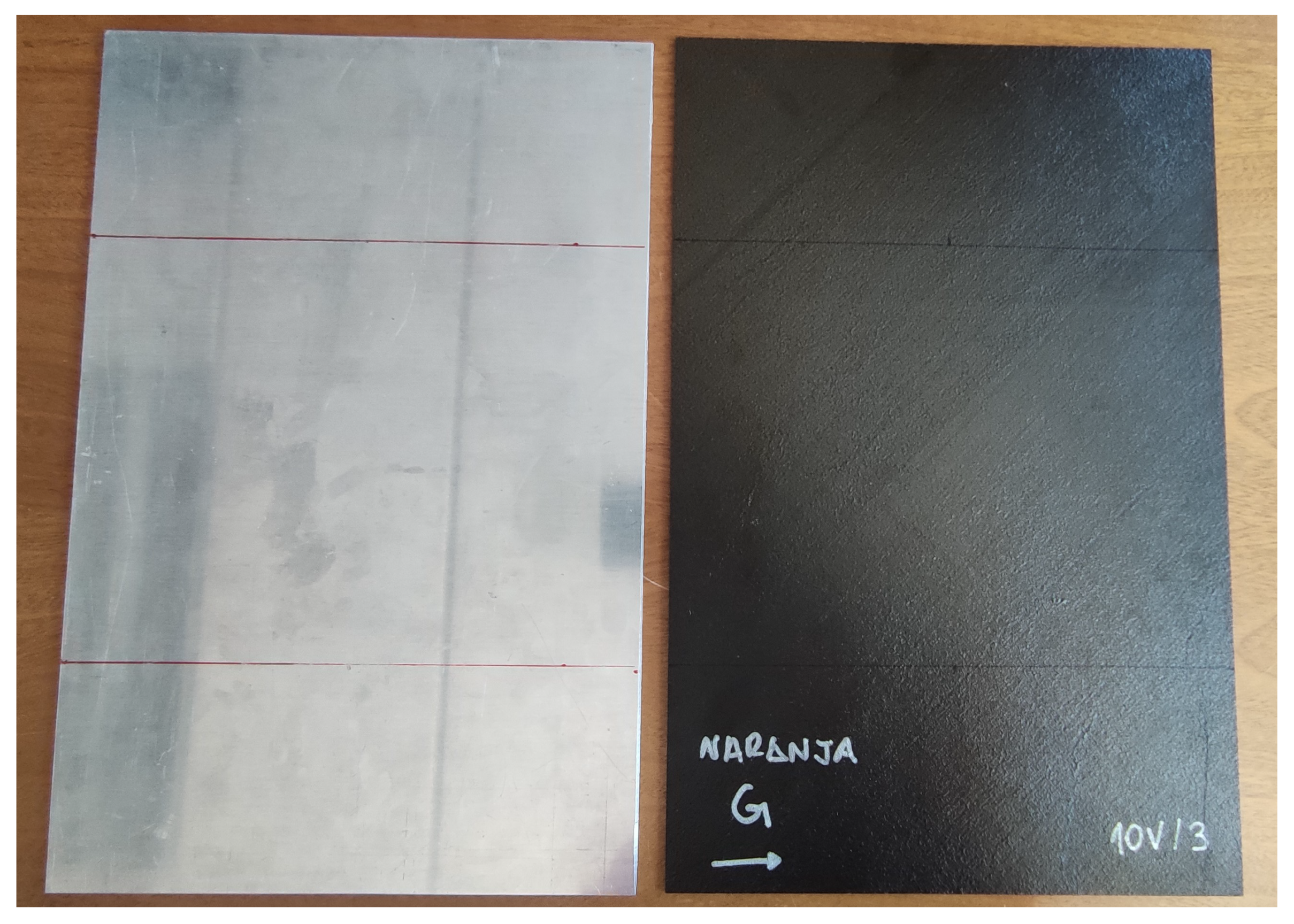

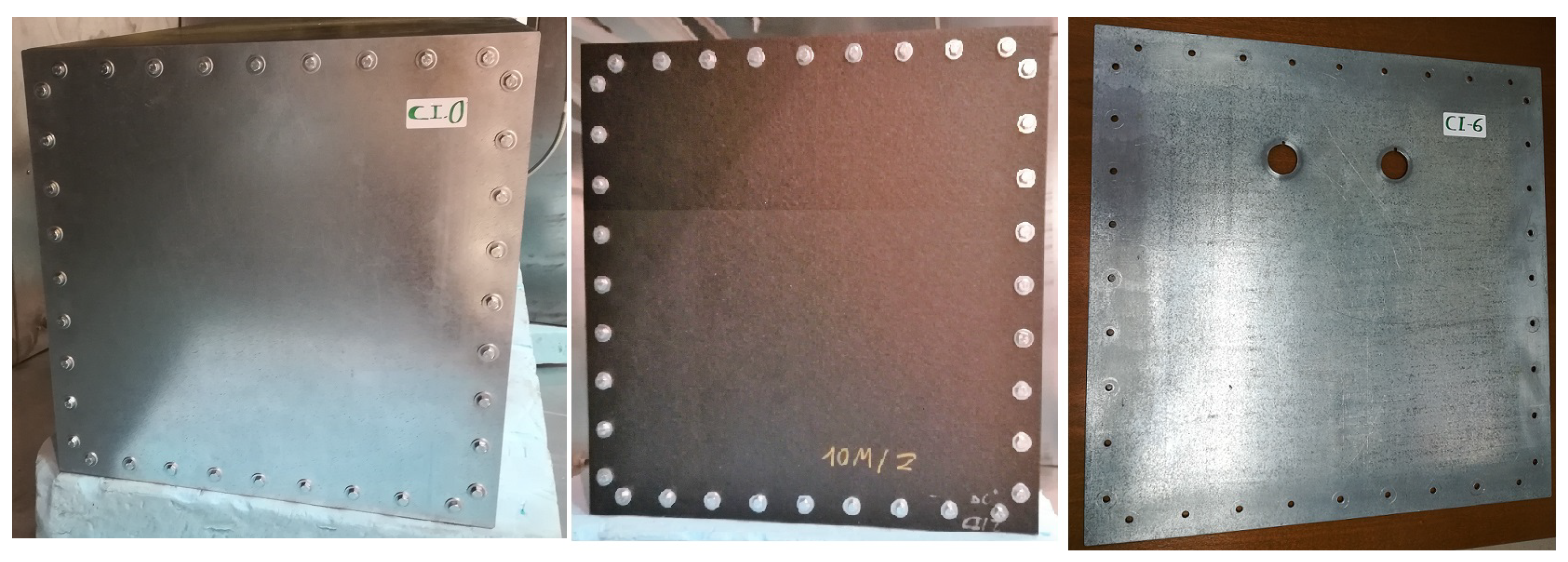

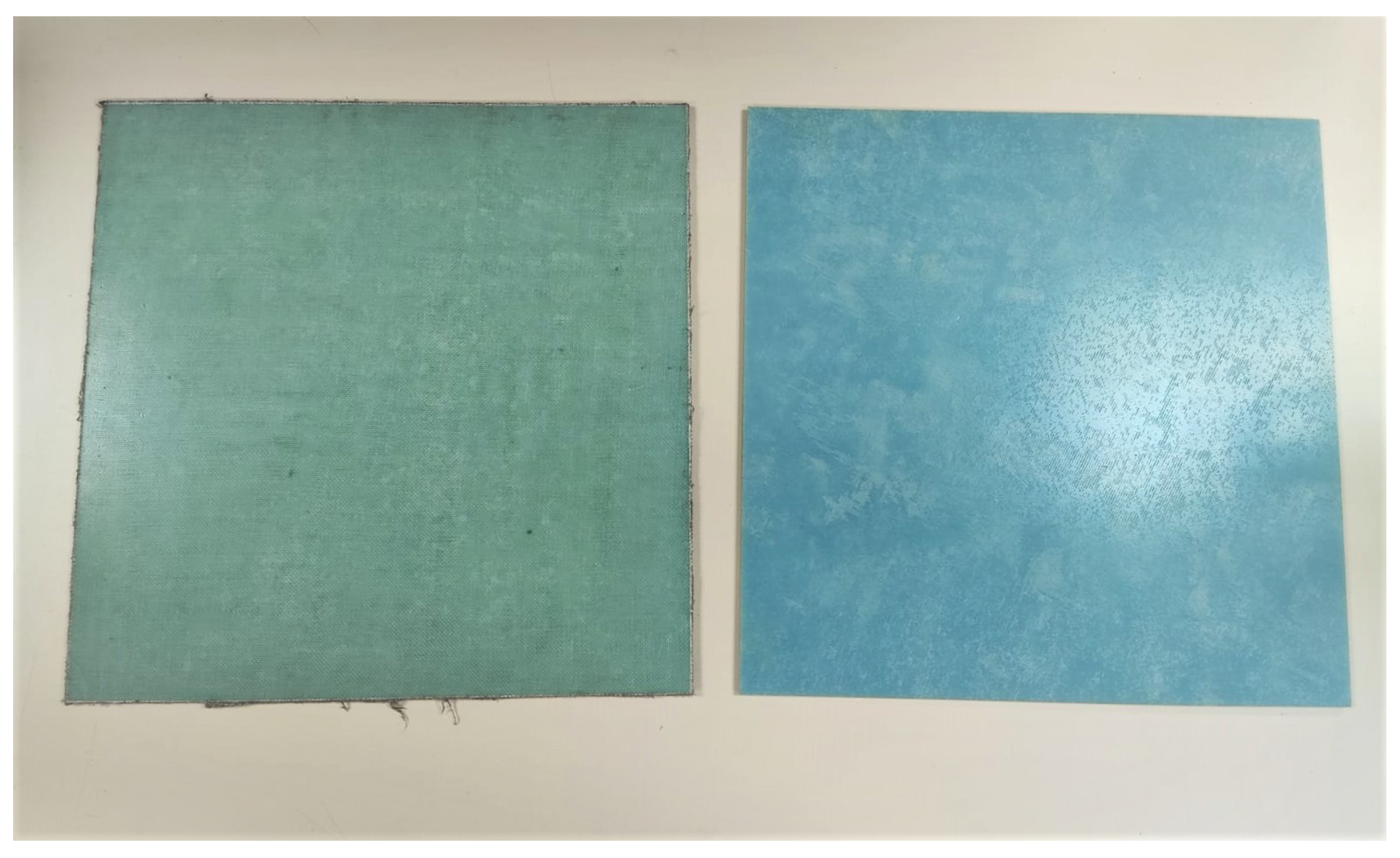

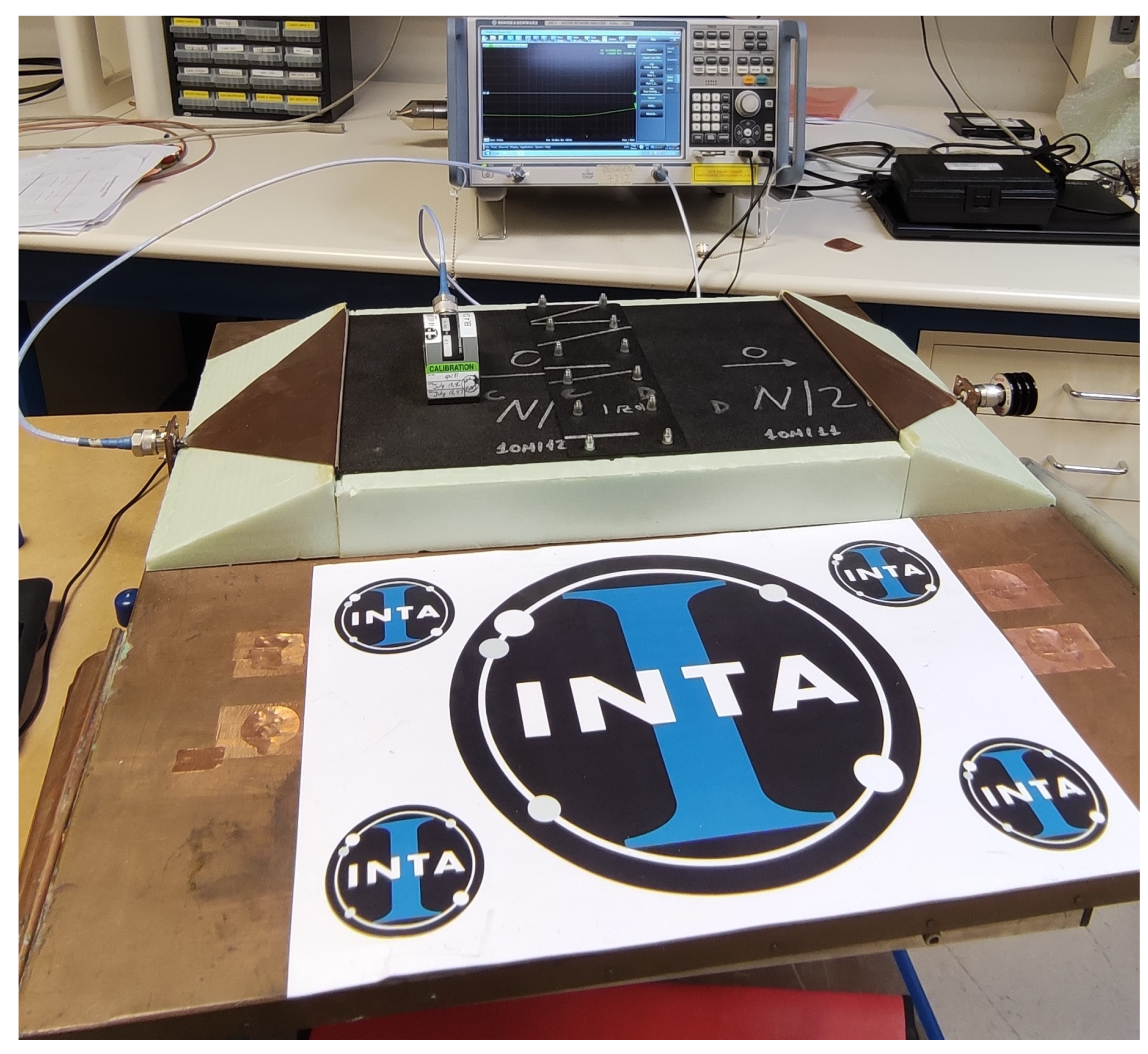
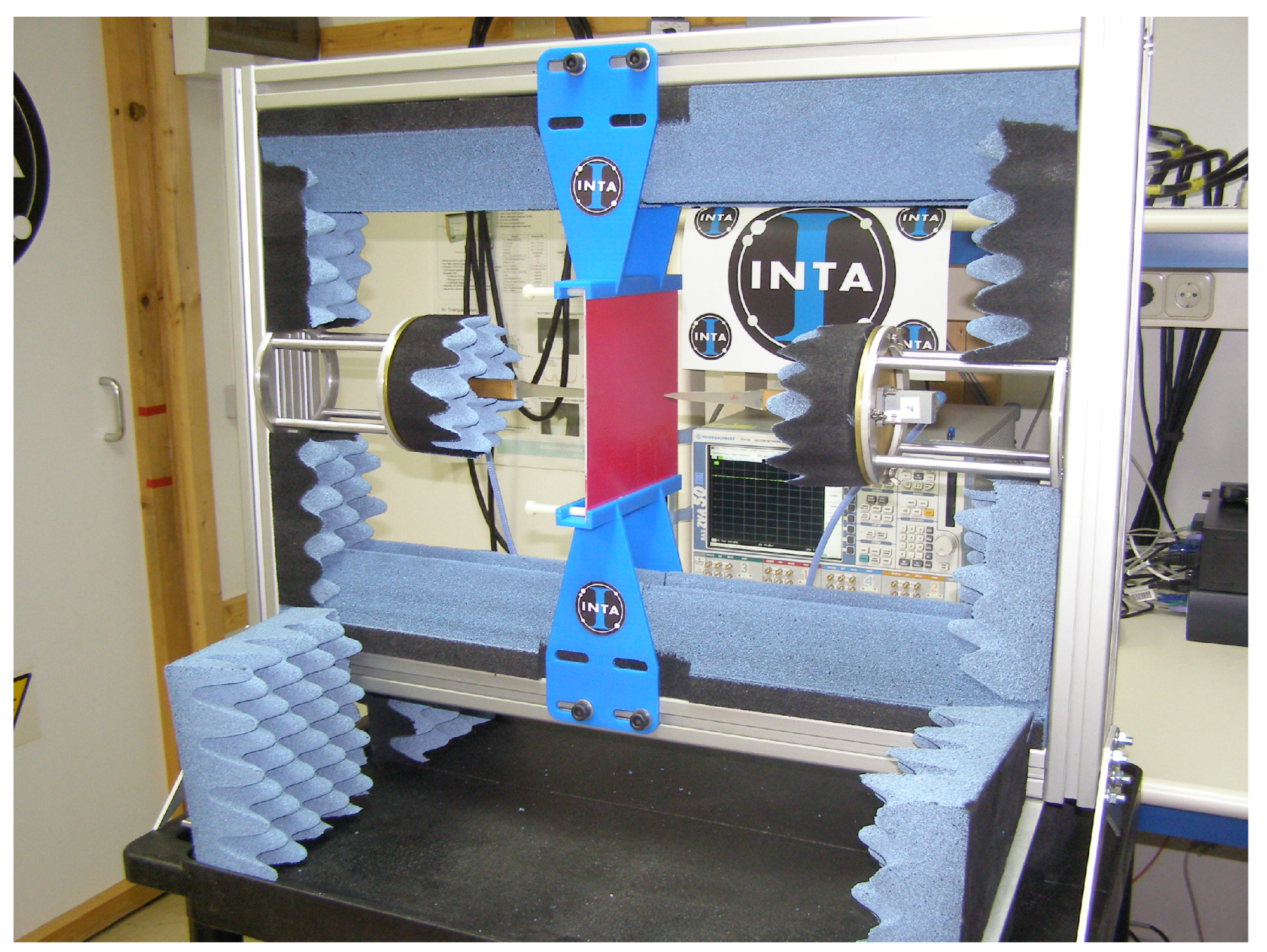
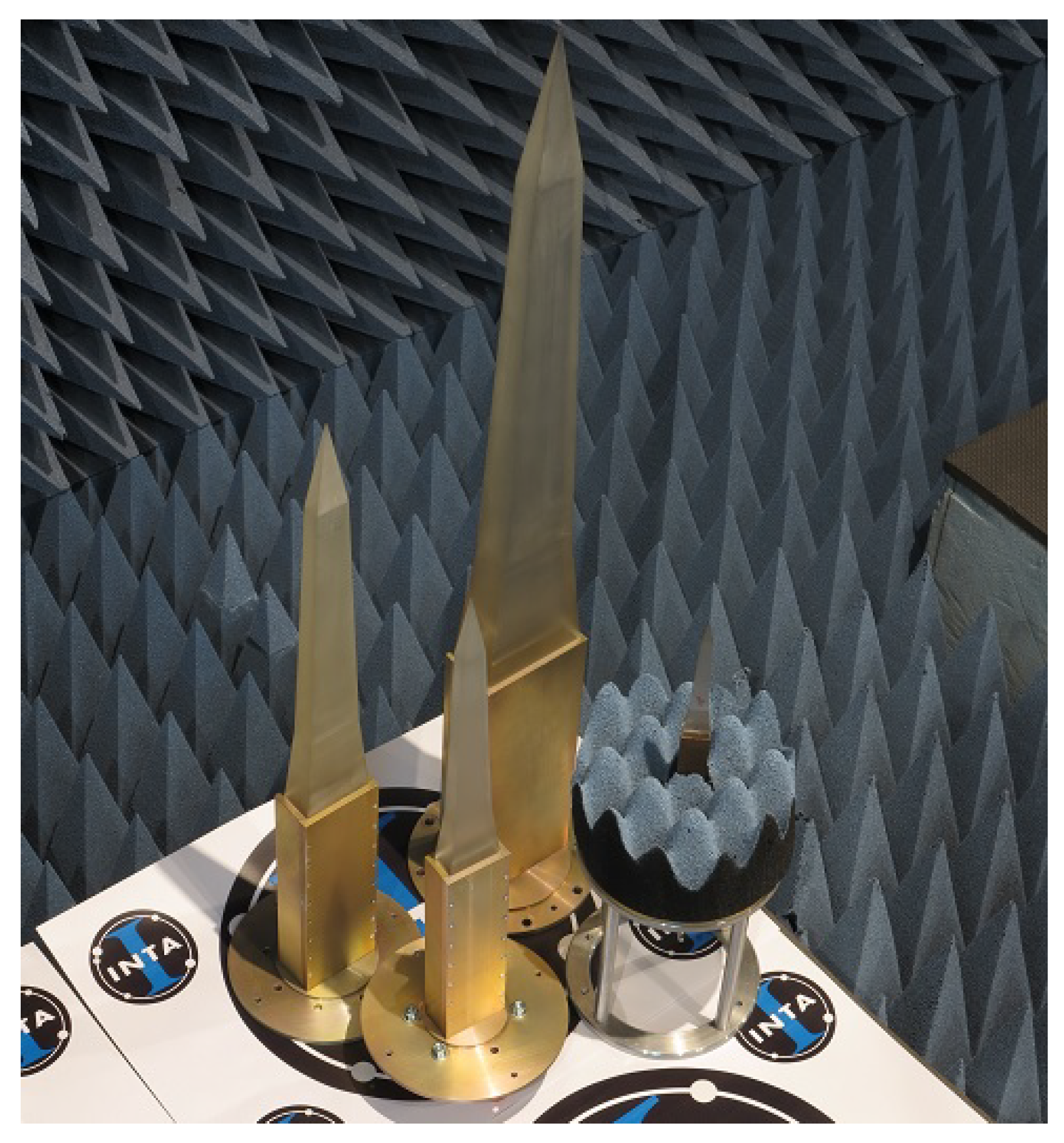
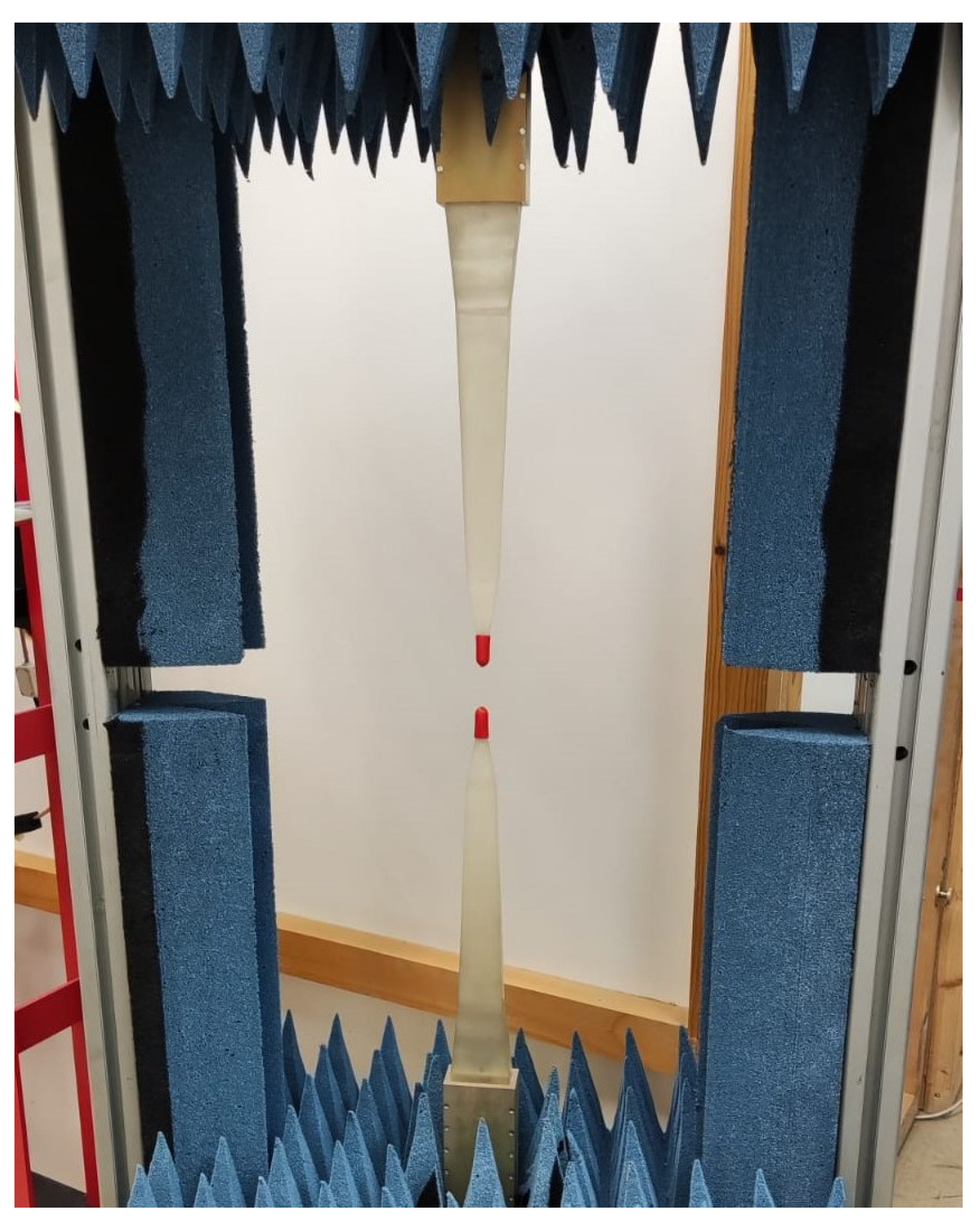
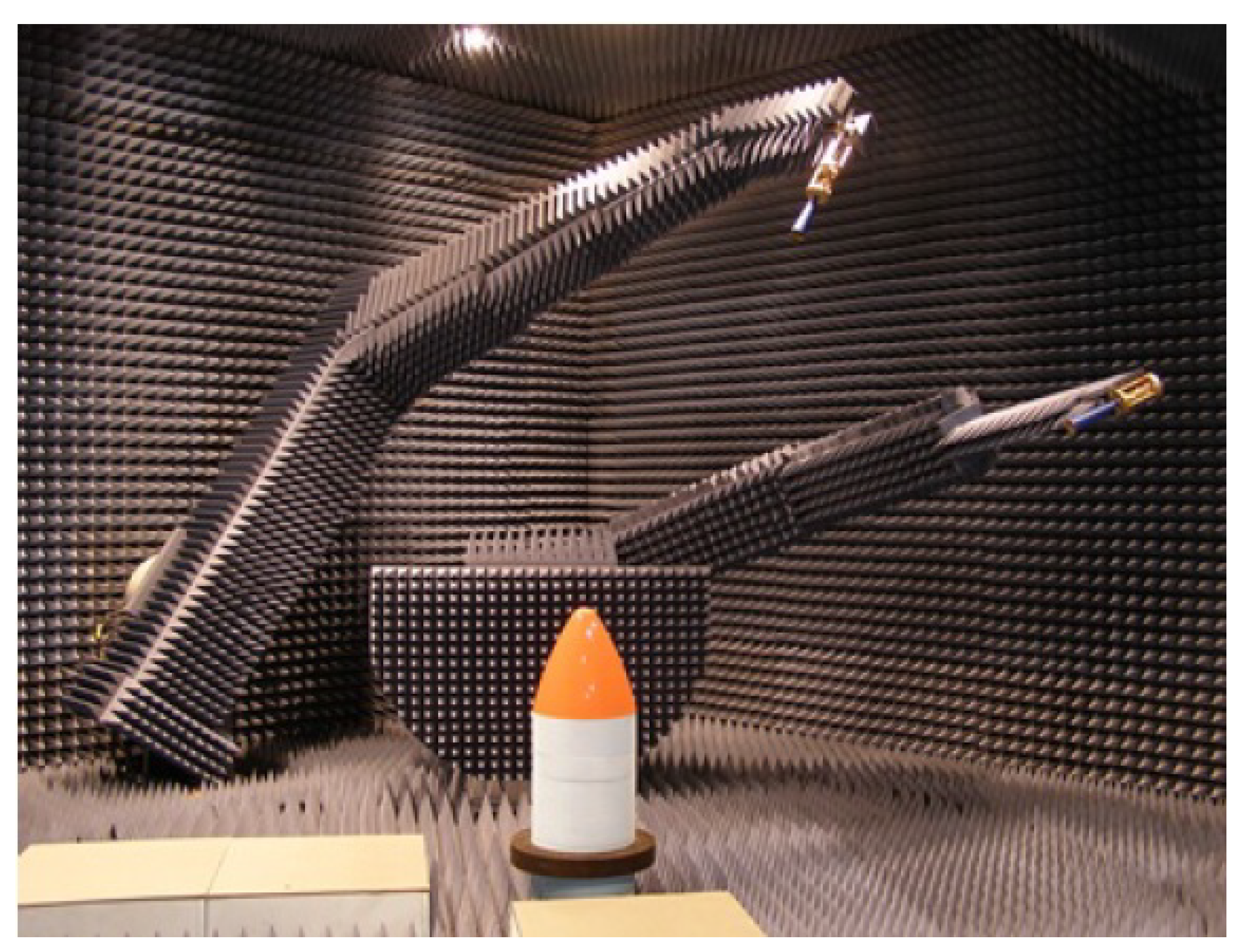
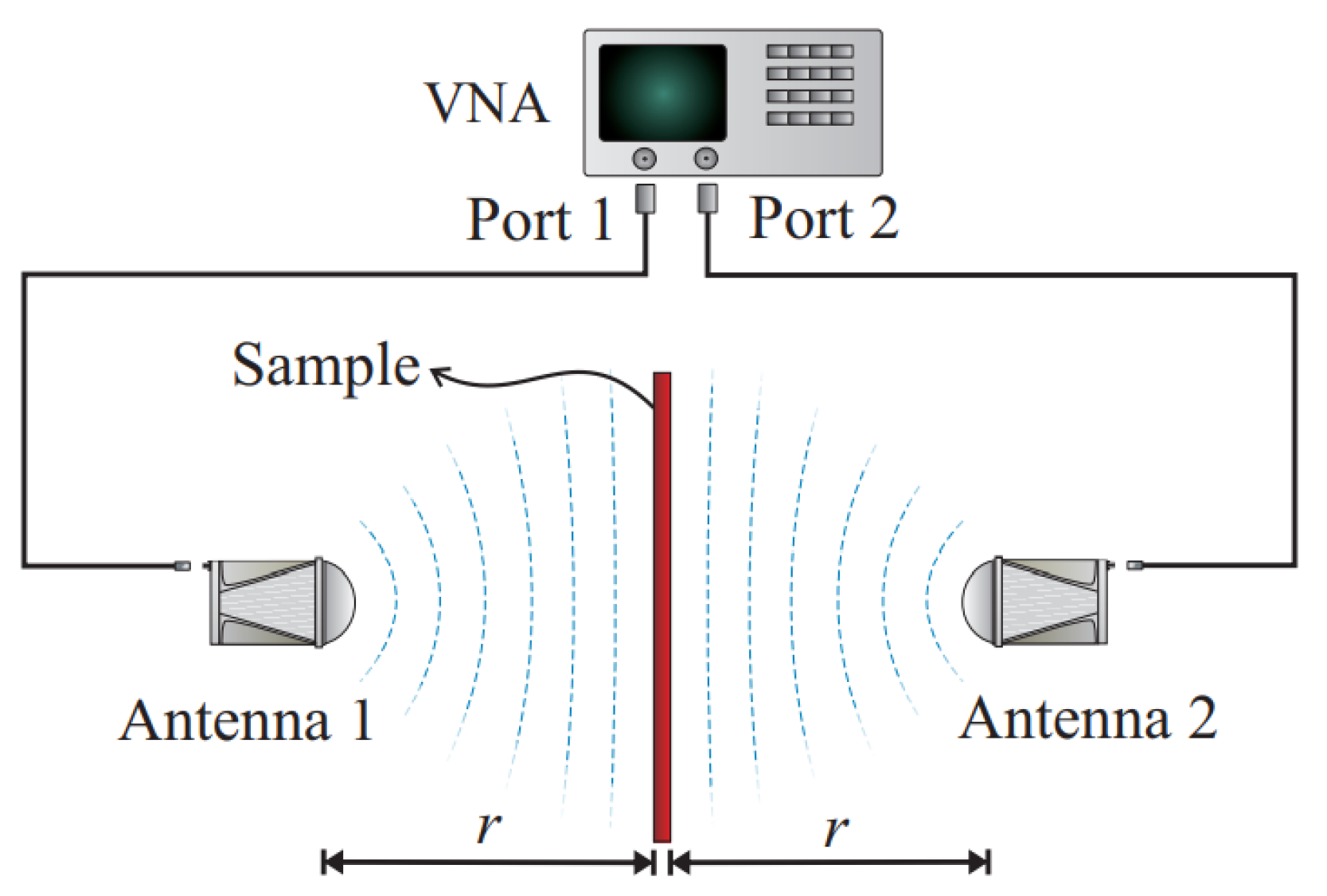
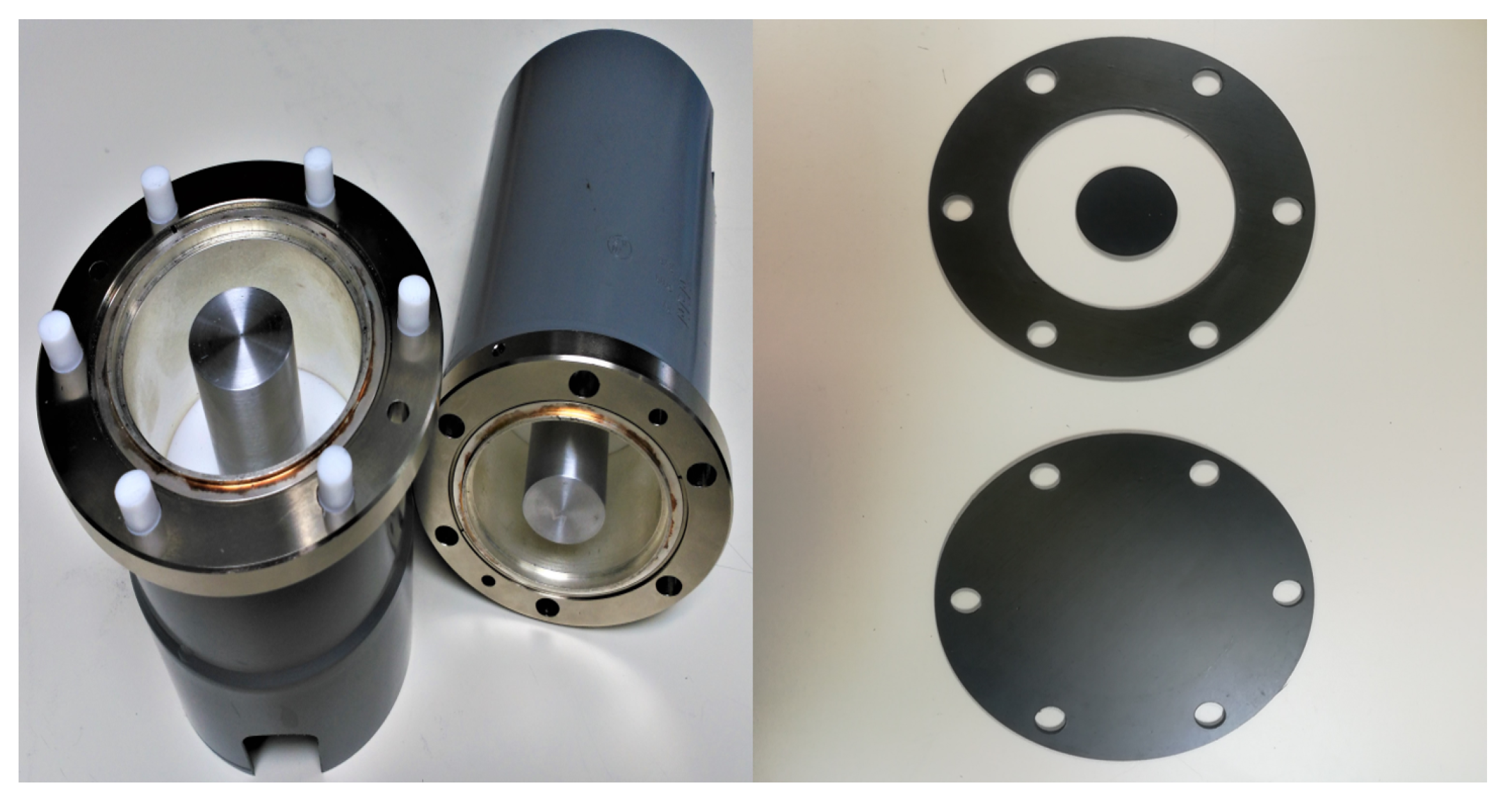

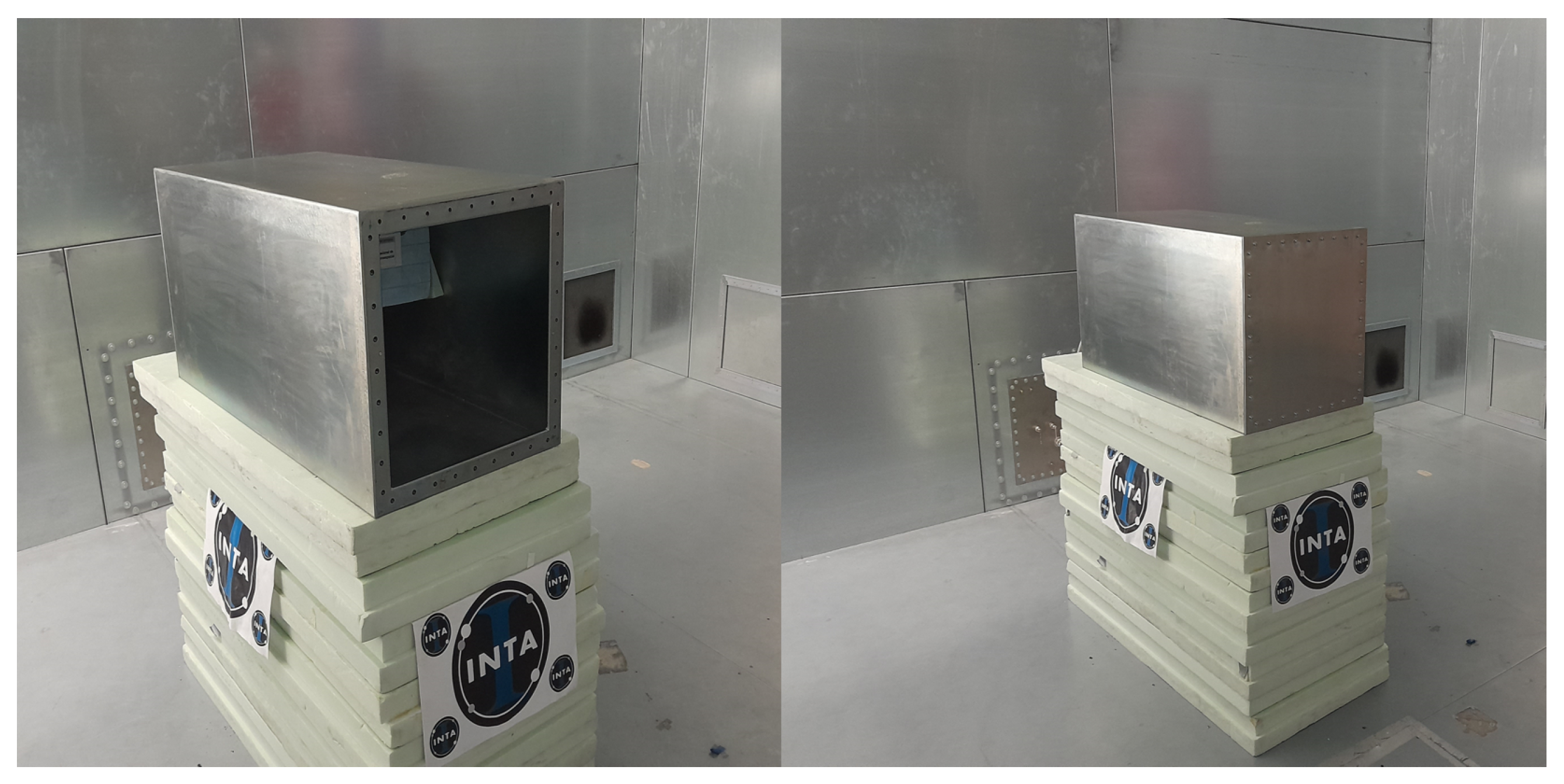
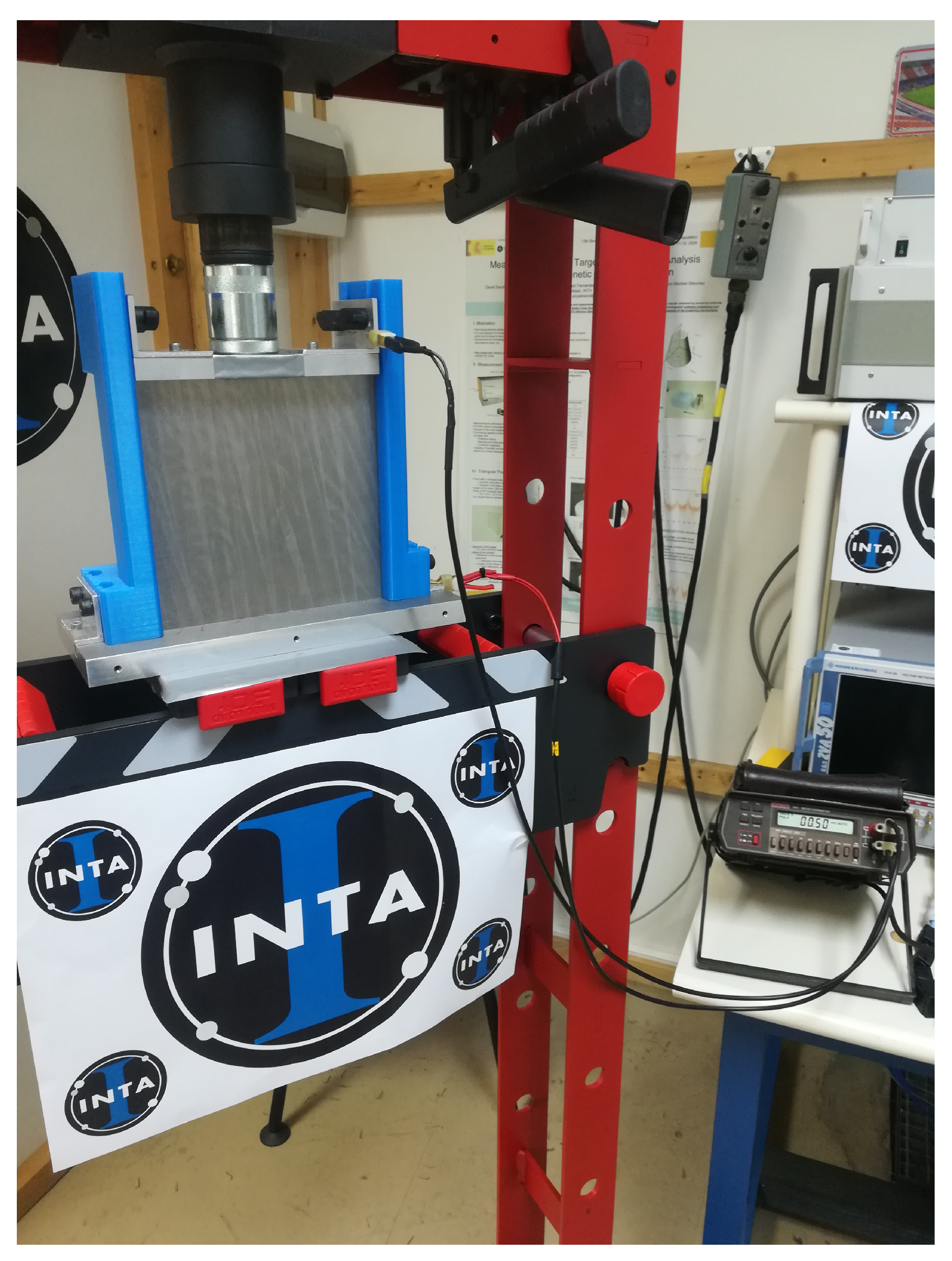
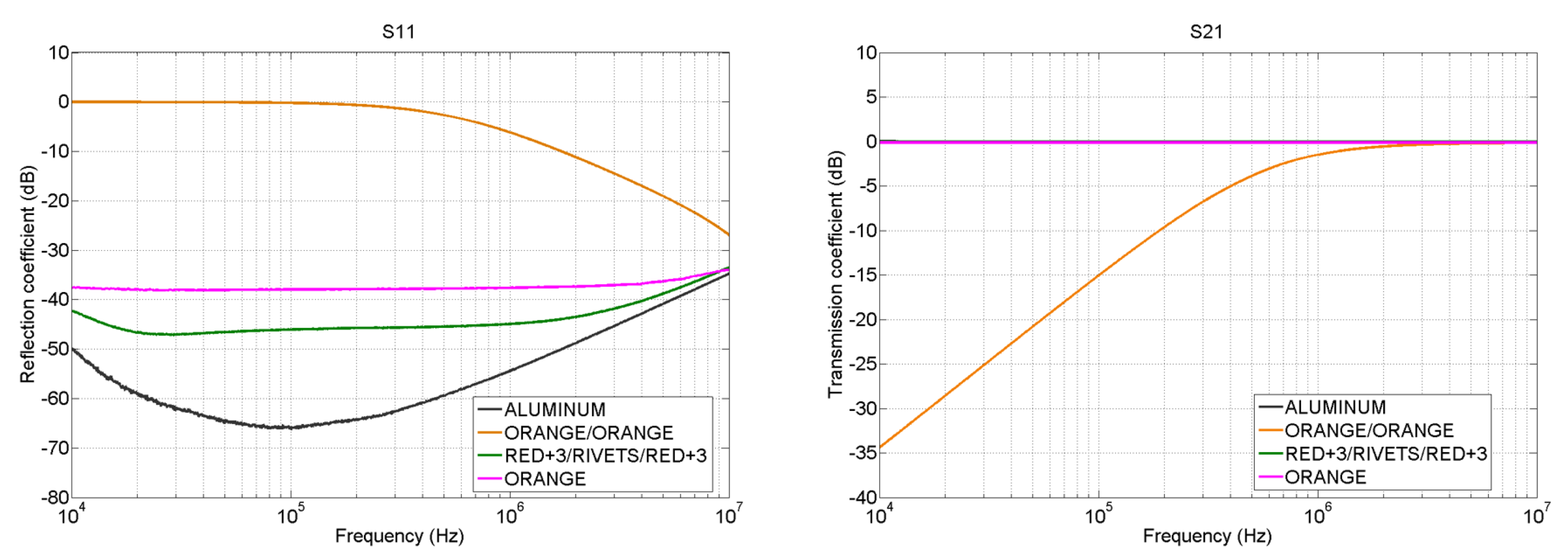
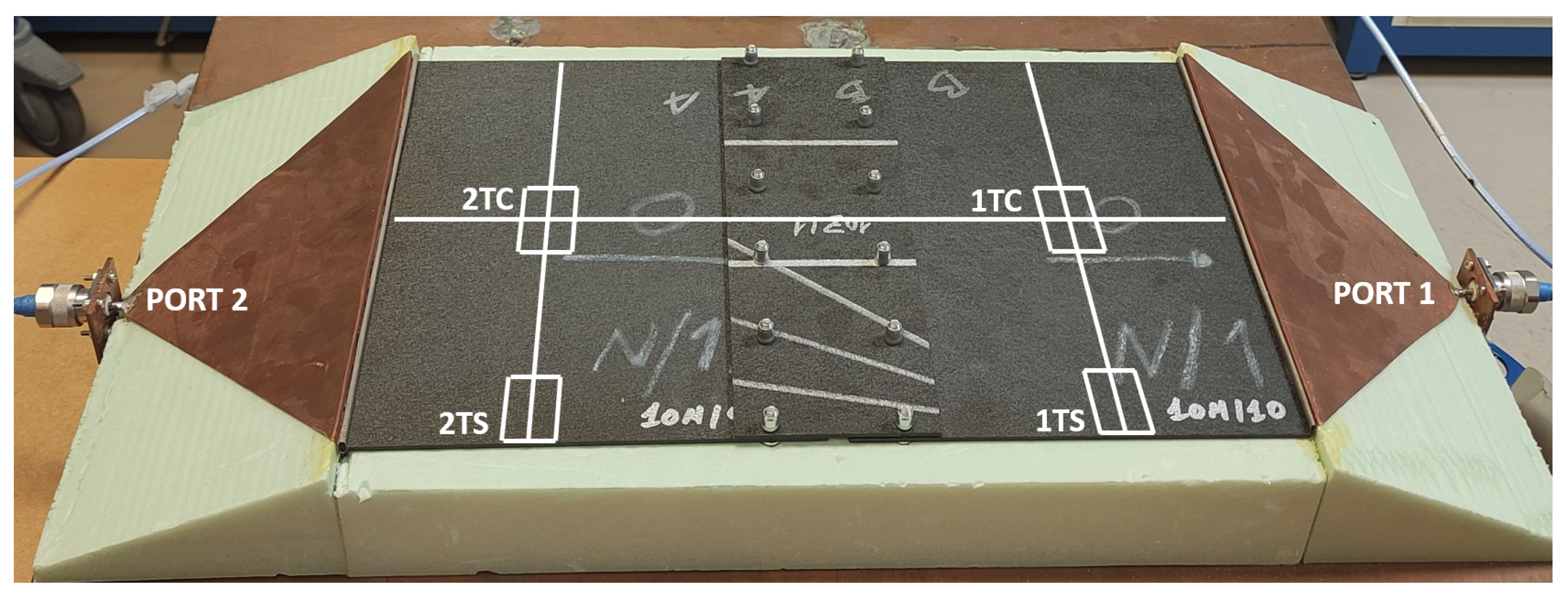

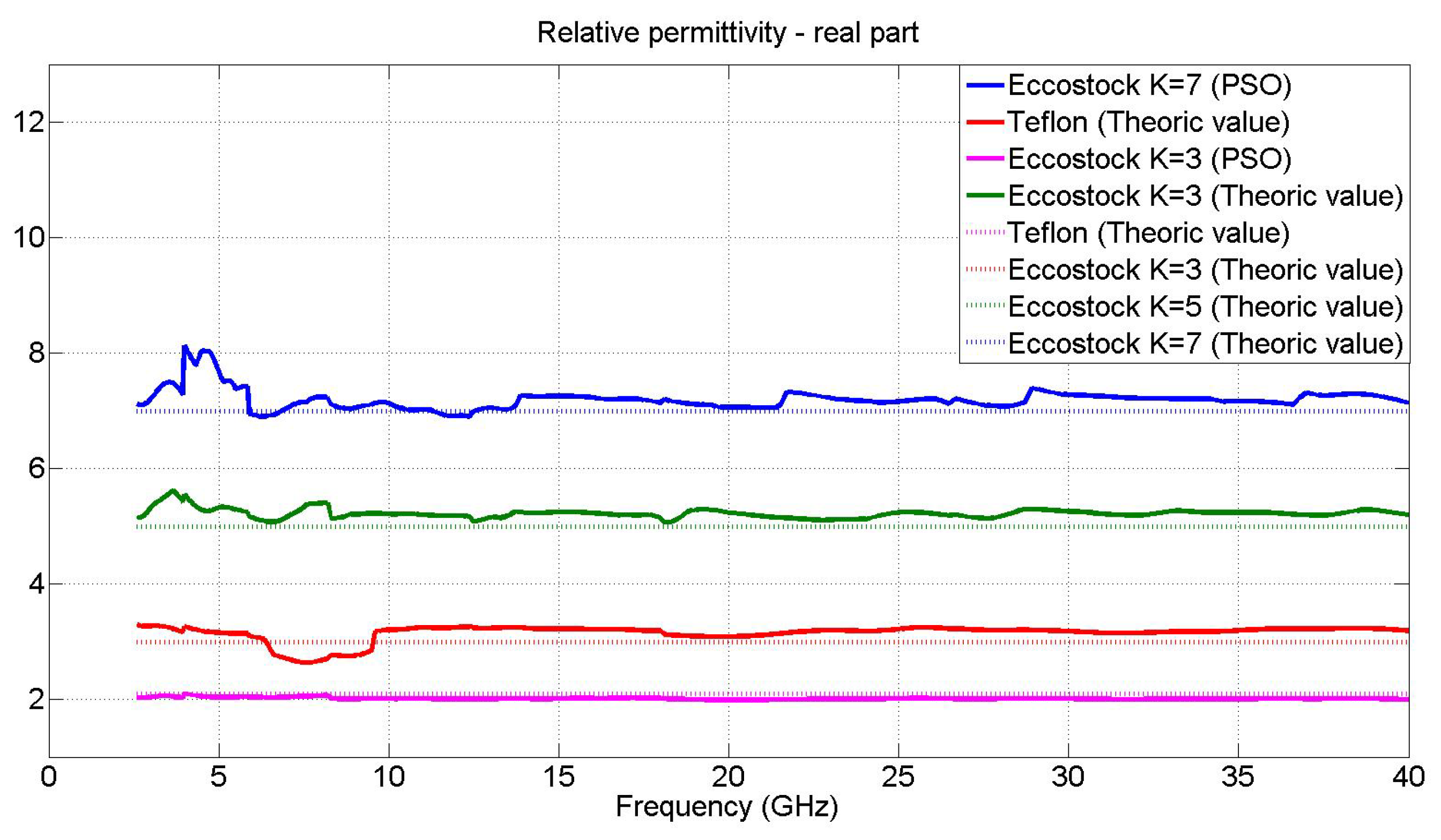
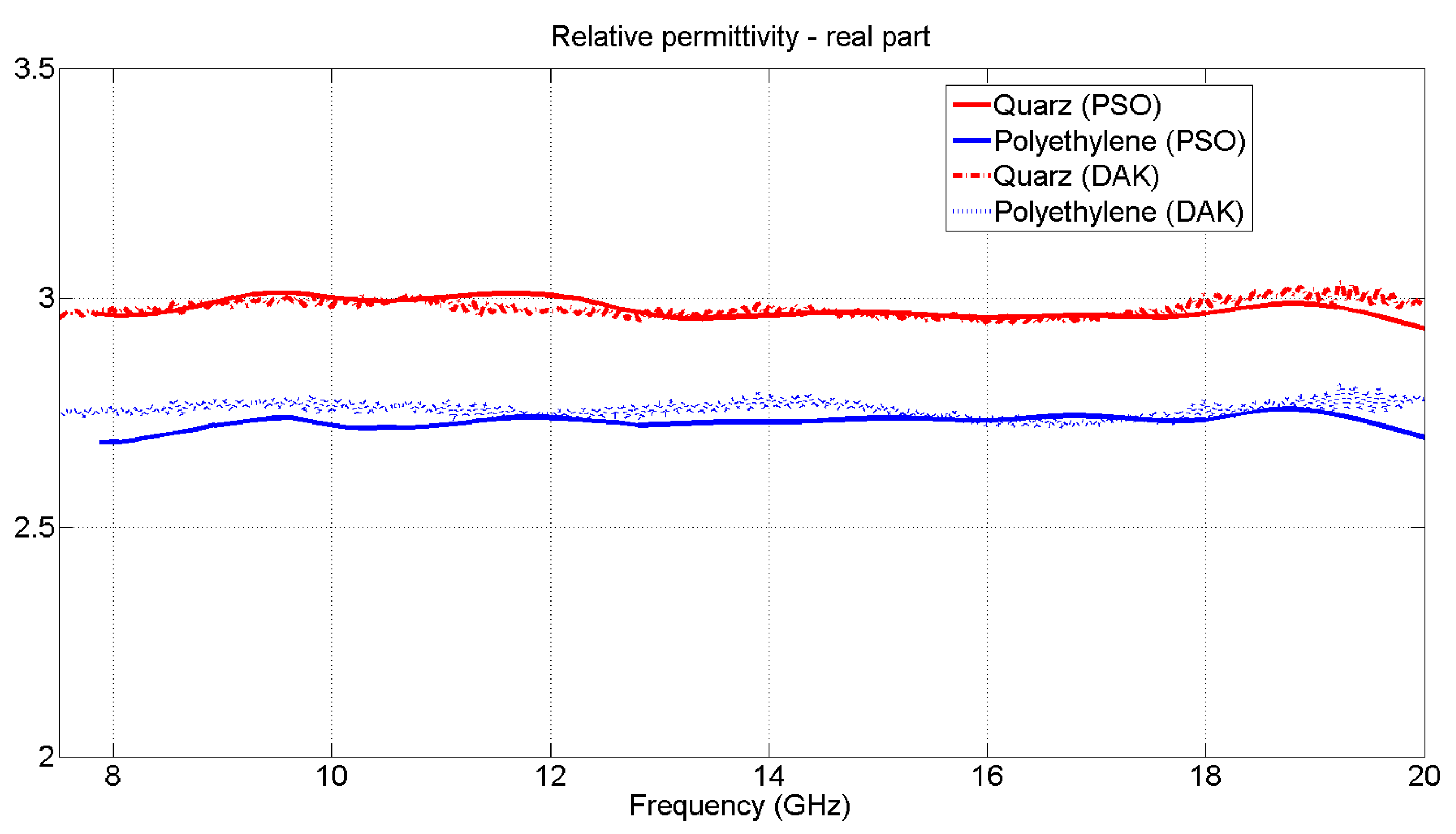


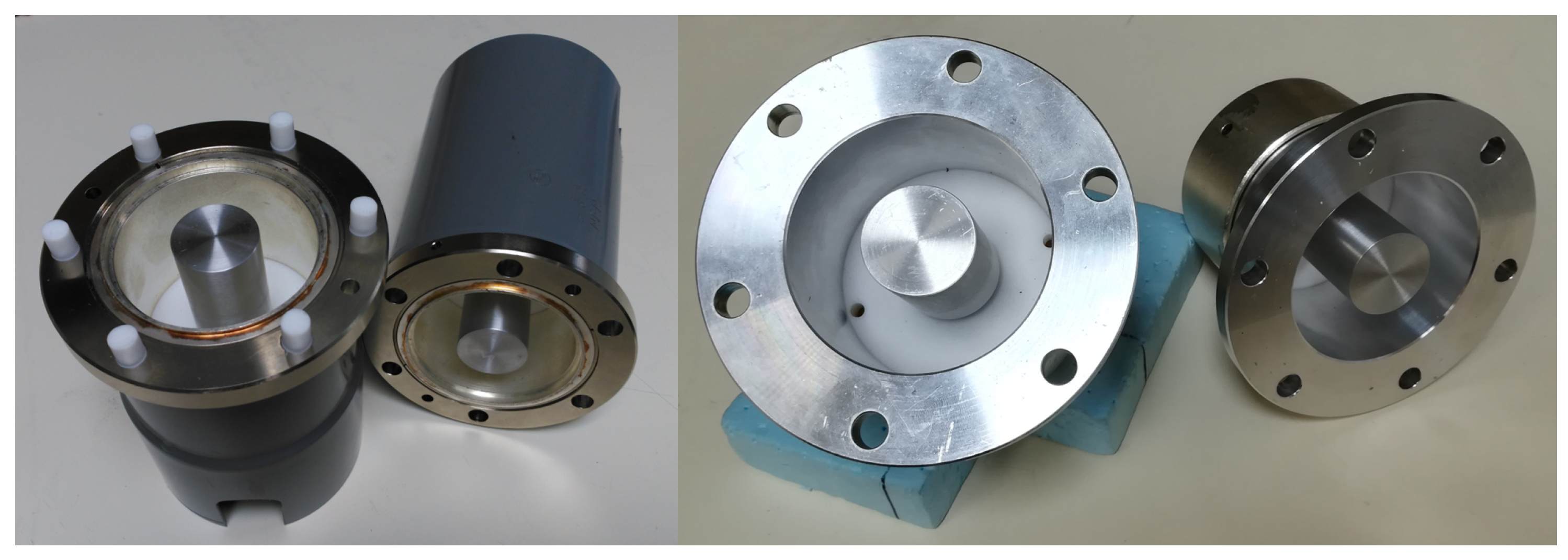
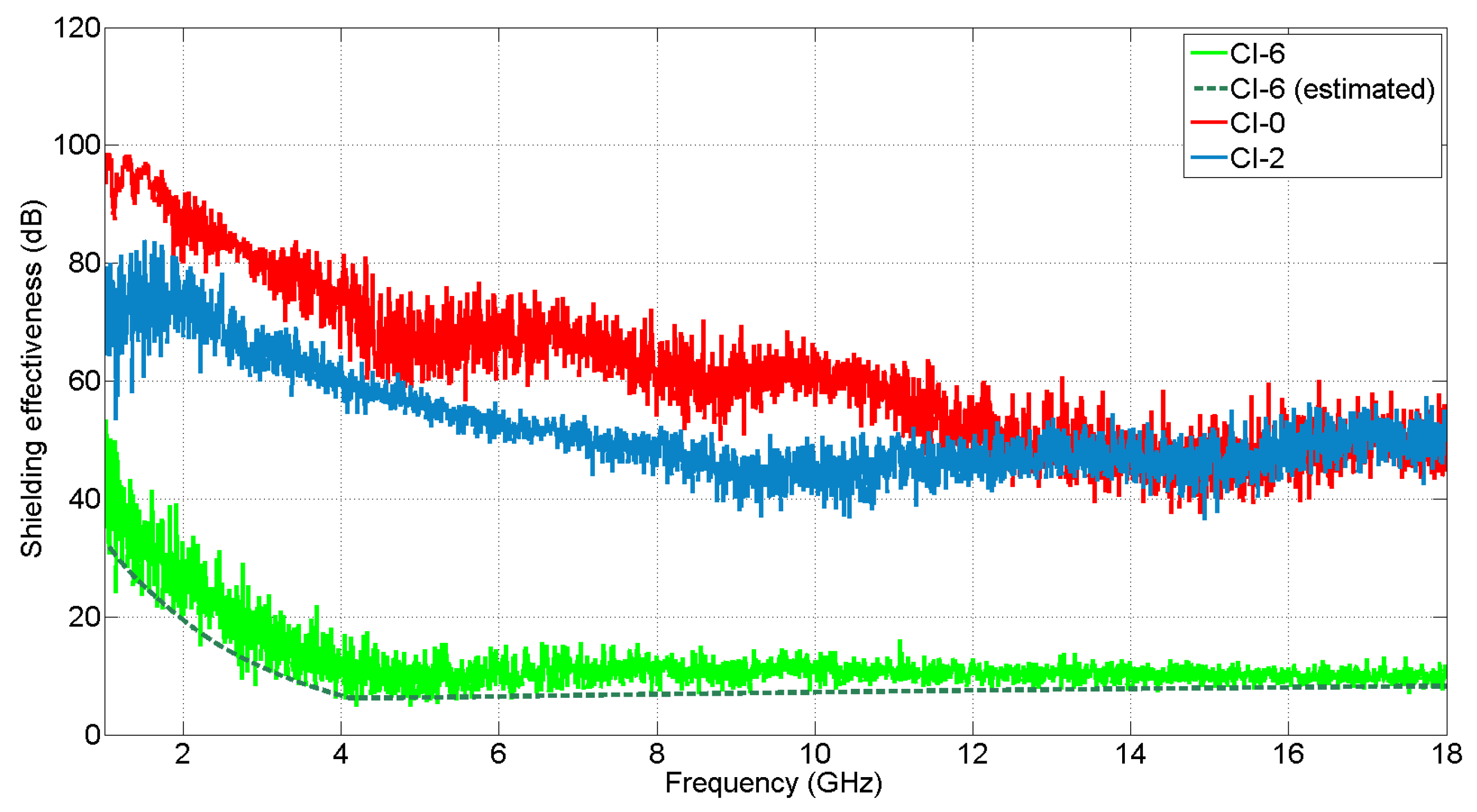
| Material | Stacking Sequence | Number of Plies |
|---|---|---|
| BLUE | [+45/−45/−45/0/+45/90/+45/0/−45/ −45/0/+45/90/+45/0/−45/−45/+45] | 18 |
| ORANGE | [+45/−45/+45/0/+45/90/+45/0/−45 /−45/0/+45/90/+45/0/+45/−45/+45] | 18 |
| RED | [+45/−45/0/−45/+45/90/ 90/+45/−45/0/−45/+45] | 12 |
| RED+3 | [45/−45/0/−45/45/90] [45/−45/0/90/0/−45/0/0/45/0/90/0] | 36 |
| Material | Stacking Sequence | Number of Plies | Resin | Permittivity Theoric Real Part [23] |
|---|---|---|---|---|
| Polyethylene | [(0/90)] | 34 | Epoxy | 2.8 |
| Quartz | [(0/90)] | 34 | Epoxy | 3.1 |
| Material | Thickness (mm) | Mean Value Permittivity—Real Part (Measure with DAK Kit) [1–20 GHz] | Mean Value Permittivity—Real Part (PSO Algorithm) [8.5–20 GHz] |
|---|---|---|---|
| Methacrylate | 2.93 | 2.56 | 2.493 |
| HIPS | 1.93 | 2.41 | 2.437 |
| PETG | 1.97 | 2.77 | 2.79 |
| PLA-white | 3.2 | 2.14 | 2.1483 |
| PLA-black | 10.2 | 2.42 | 2.442 |
| Name | Square Resistance | Estimated SE for f < 30 MHz |
|---|---|---|
| Aluminum | 0.5 m | Not applicable |
| RED | 99.6 m | 75.2 dB |
| BLUE | 46.4 m | 78.7 dB |
Publisher’s Note: MDPI stays neutral with regard to jurisdictional claims in published maps and institutional affiliations. |
© 2022 by the authors. Licensee MDPI, Basel, Switzerland. This article is an open access article distributed under the terms and conditions of the Creative Commons Attribution (CC BY) license (https://creativecommons.org/licenses/by/4.0/).
Share and Cite
Ramos, D.; Cidrás, J.; Plaza, B.; Moravec, C.; de la Torre, A.; Frövel, M.R.K.; Poyatos, D. Novel Electromagnetic Characterization Methods for New Materials and Structures in Aerospace Platforms. Materials 2022, 15, 5128. https://doi.org/10.3390/ma15155128
Ramos D, Cidrás J, Plaza B, Moravec C, de la Torre A, Frövel MRK, Poyatos D. Novel Electromagnetic Characterization Methods for New Materials and Structures in Aerospace Platforms. Materials. 2022; 15(15):5128. https://doi.org/10.3390/ma15155128
Chicago/Turabian StyleRamos, David, José Cidrás, Borja Plaza, Carolina Moravec, Antonia de la Torre, Malte Richard Karl Frövel, and David Poyatos. 2022. "Novel Electromagnetic Characterization Methods for New Materials and Structures in Aerospace Platforms" Materials 15, no. 15: 5128. https://doi.org/10.3390/ma15155128
APA StyleRamos, D., Cidrás, J., Plaza, B., Moravec, C., de la Torre, A., Frövel, M. R. K., & Poyatos, D. (2022). Novel Electromagnetic Characterization Methods for New Materials and Structures in Aerospace Platforms. Materials, 15(15), 5128. https://doi.org/10.3390/ma15155128






